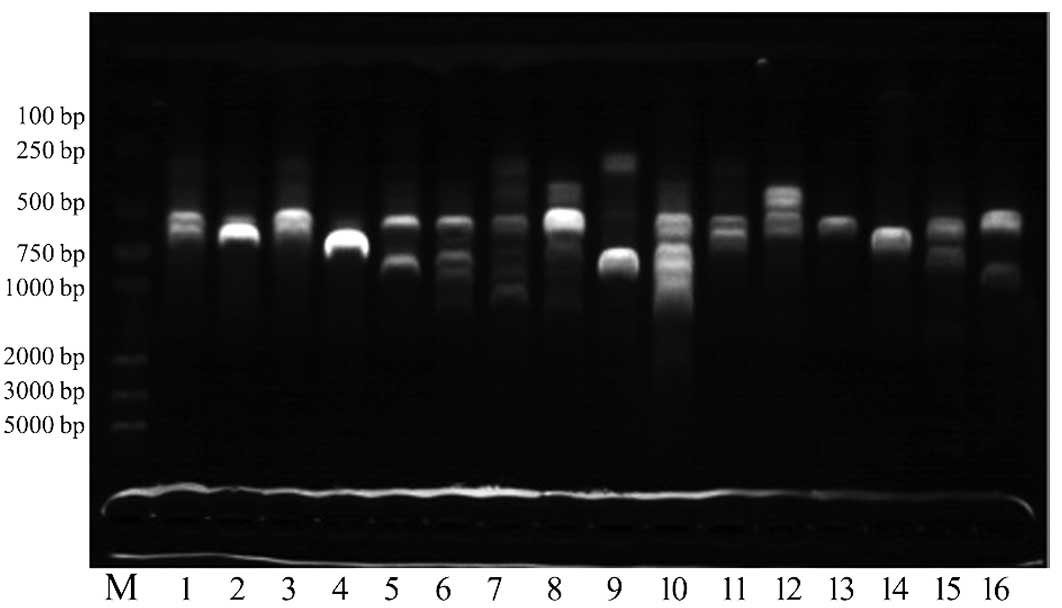Antibiotic susceptibility and genotype patterns of Pseudomonas aeruginosa from mechanical ventilation-associated pneumonia in intensive care units
- Authors:
- Hui Xiao
- Xiong Ye
- Qingzhong Liu
- Li Li
-
View Affiliations
Affiliations: Department of Laboratory Medicine, Shanghai First People's Hospital, Medical College, Shanghai Jiao Tong University, Shanghai 200080, P.R. China, Department of Respiratory Medicine, PuDong Hospital, Shanghai 200319, P.R. China
- Published online on: April 16, 2013 https://doi.org/10.3892/br.2013.94
-
Pages:
589-593
Abstract
Pseudomonas aeruginosa (P. aeruginosa) is a leading cause of morbidity and mortality in patients with ventilation‑associated pneumonia (VAP). It is difficult to treat this infection due to acquired resistance to various antibiotics. In order to understand the potential route of transmission, it is important to have detailed knowledge of the genotypes and antibiotic susceptibility of P. aeruginosa. The aim of this study was to determine antibiotic susceptibility using the broth microdilution minimum inhibitory concentration (MIC) method and to apply the Randomly Amplified Polymorphic DNA (RAPD) typing method for VAP caused by P. aeruginosa in 16 patients (8 men and 8 women; average age at inclusion, 67.8 years; range, 53-76 years). To determine antibiotic susceptibility, imipenem (IPM), cefepime (FEP) and meropenem (MEM) were administered for the treatment of P. aeruginosa, yielding an effectiveness of 75, 62.5, and 62.5%, respectively. According to the National Committee for Clinical Laboratory Standards (NCCLS) breakpoints, 8 (50%) of the 16 mechanical ventilation (MV) isolates were resistant to ceftazidime (CAZ) and pipenacillin (PIP). Amikacin (AK) and aztreonam (AZT) were not as effective against P. aeruginosa (75%). In addition, P. aeruginosa was completely resistant to ciprofloxacin (CIP). The MV isolates were susceptible to polymyxin B (PB). RAPD analysis revealed 12 genotypes for all the isolated P. aeruginosa, separated into 4 patterns. The results demonstrated a high incidence of P. aeruginosa isolated from VAP, with endogenous and cross infections being potential reasons for P. aeruginosa isolated from VAP in the intensive care units.
View References
|
1
|
Fricks-Lima J, Hendrickson CM, Allgaier M,
et al: Differences in biofilm formation and antimicrobial
resistance of Pseudomonas aeruginosa isolated from airways
of mechanically ventilated patients and cystic fibrosis patients.
Int J Antimicrob Agents. 37:309–315. 2011.PubMed/NCBI
|
|
2
|
Garnacho-Montero J, Sa-Borges M,
Sole-Violan J, et al: Optimal management therapy for Pseudomonas
aeruginosa ventilator-associated pneumonia: an observational,
multicenter study comparing monotherapy with combination antibiotic
therapy. Critical Care Med. 35:1888–1895. 2007.PubMed/NCBI
|
|
3
|
Sevillano E, Valderrey C, Canduela MJ,
Umaran A, Calvo F and Gallego L: Resistance to antibiotics in
clinical isolates of Pseudomonas aeruginosa. Pathol Biol
(Paris). 54:493–497. 2006.PubMed/NCBI
|
|
4
|
Libisch B, Watine J, Balogh B, et al:
Molecular typing indicates an important role for two international
clonal complexes in dissemination of VIM-producing Pseudomonas
aeruginosa clinical isolates in Hungary. Res Microbiol.
159:162–168. 2008. View Article : Google Scholar : PubMed/NCBI
|
|
5
|
Bradbury R, Champion A and Reid DW: Poor
clinical outcomes associated with a multi-drug resistant clonal
strain of Pseudomonas aeruginosa in the Tasmanian cystic
fibrosis population. Respirology. 13:886–892. 2008. View Article : Google Scholar : PubMed/NCBI
|
|
6
|
Mahenthiralingam E, Campbell ME, Foster J,
Lam JS and Speert DP: Random amplified polymorphic DNA typing of
Pseudomonas aeruginosa isolates recovered from patients with
cystic fibrosis. J Clin Microbiol. 34:1129–1135. 1996.
|
|
7
|
Crnich J, Safdar N and Maki DG: The role
of the intensive care unit environment in the pathogenesis and
prevention of ventilator-associated pneumonia. Respir Care.
50:813–838. 2005.PubMed/NCBI
|
|
8
|
Gil-Perotin S, Ramirez P, Marti V, et al:
Implications of endotracheal tube biofilm in ventilator-associated
pneumonia response: a state of concept. Crit Care. 16:R932012.
View Article : Google Scholar : PubMed/NCBI
|
|
9
|
Trouillet JL: Ventilator-associated
pneumonia: a comprehensive review. Hosp Pract (Minneap).
40:165–175. 2012. View Article : Google Scholar : PubMed/NCBI
|
|
10
|
Farah R and Makhoul N: Optimal time needed
for withdrawal of mechanical ventilation in patients with chronic
obstructive pulmonary disease. Isr Med Assoc J. 13:609–612.
2011.PubMed/NCBI
|
|
11
|
Arnold HM, Sawyer AM and Kollef MH: Use of
adjunctive aerosolized antimicrobial therapy in the treatment of
Pseudomonas aeruginosa and Acinetobacter baumannii
ventilator-associated pneumonia. Respir Care. 57:1226–1233. 2012.
View Article : Google Scholar : PubMed/NCBI
|
|
12
|
Bassetti M, Taramasso L, Giacobbe DR and
Pelosi P: Management of ventilator-associated pneumonia:
epidemiology, diagnosis and antimicrobial therapy. Expert Rev Anti
Infect Ther. 10:585–596. 2012. View Article : Google Scholar : PubMed/NCBI
|
|
13
|
Mahida K and Kwon DH: Co-existence of
multidrug-resistant and -susceptible strains of Pseudomonas
aeruginosa from a single clinical isolate. Curr Microbiol.
61:19–24. 2010. View Article : Google Scholar : PubMed/NCBI
|
|
14
|
Ruiz L, Dominguez MA, Ruiz N and Vinas M:
Relationship between clinical and environmental isolates of
Pseudomonas aeruginosa in a hospital setting. Arch Med Res.
35:251–257. 2004. View Article : Google Scholar : PubMed/NCBI
|












